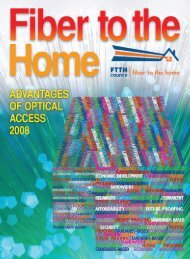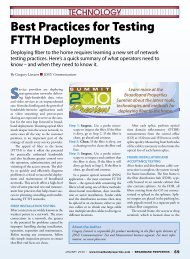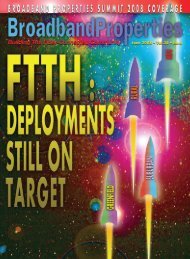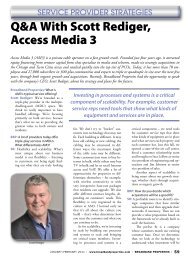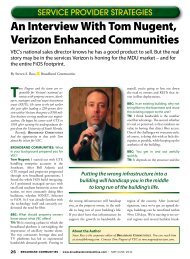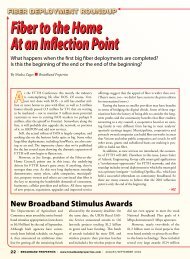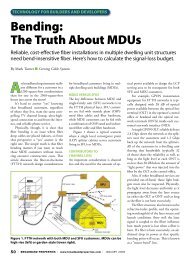2010 Buyers Guide - Broadband Properties
2010 Buyers Guide - Broadband Properties
2010 Buyers Guide - Broadband Properties
You also want an ePaper? Increase the reach of your titles
YUMPU automatically turns print PDFs into web optimized ePapers that Google loves.
FTTH CONFERENCE COVERAGE<br />
Highlights of the Houston<br />
Fiber-to-the-Home Conference<br />
Speakers at the September 2009 FTTH Conference shared<br />
their experiences building and operating fiber-to-the-home<br />
systems and explained why FTTH is critical to the future of<br />
the United States.<br />
A BBP Staff Report<br />
RUS Official: United States Needs<br />
A Next-Gen Network<br />
The United States cannot maintain<br />
world leadership without a<br />
next-generation broadband infrastructure,<br />
a Department of Agriculture<br />
official told the FTTH Conference. Jessica<br />
Zufolo, deputy administrator of the<br />
USDA’s Rural Utilities Service (RUS),<br />
said in a keynote address that there were<br />
many challenges and cost barriers to providing<br />
universal access to high-speed facilities<br />
as envisioned in the American Recovery<br />
and Reinvestment Act (ARRA),<br />
that the high costs of rural investment<br />
had deterred some carriers, but that the<br />
investment was critical for the country.<br />
Zufolo cited a report from the USDA’s<br />
Economic Research Service (discussed in<br />
the December 2008 issue of this magazine)<br />
showing that employment growth<br />
and earnings were higher in areas that<br />
obtained earlier access to broadband.<br />
Though RUS programs are technology<br />
neutral, Zufolo said, more than<br />
90 percent of the broadband loans the<br />
agency has made in the last two years<br />
have been for fiber to the home. More<br />
than $500 million will be available<br />
for rural broadband in this year’s farm<br />
bill, in addition to the funds available<br />
through the broadband stimulus<br />
program. In fact, RUS has become the<br />
seventh-largest bank in the United<br />
States, she said, and is an extremely costeffective<br />
loan administrator.<br />
Zufolo said she saw the agency’s mission<br />
as similar to that of its predecessor,<br />
the Rural Electrification Administration<br />
(REA), in the 1930s. The REA was able<br />
to stimulate economic activity in areas<br />
badly hit by the Depression.<br />
Despite these historical parallels, the<br />
broadband stimulus program currently<br />
under way is an “unprecedented project,”<br />
Zufolo said, due to its scale and timetable.<br />
She said the agency had learned a great<br />
deal from the first funding round (which<br />
was oversubscribed by a factor of seven<br />
and for which awards have not yet been<br />
made) and planned to make changes in<br />
the second funding round. Definitions of<br />
such statutory terms as “remote,” “rural,”<br />
“unserved” and “underserved” were controversial<br />
and may be reviewed. “Everything<br />
is on the table,” Zufolo said.<br />
Zufolo encouraged all audience<br />
members to work with RUS in making<br />
Although the RUS is technology neutral, most<br />
of its recent broadband loans have financed<br />
fiber-to-the-home projects.<br />
broadband universally affordable and accessible<br />
throughout the United States.<br />
Large Carriers and<br />
the <strong>Broadband</strong> Stimulus<br />
Program<br />
In a separate panel discussion, Eric<br />
Reed of Verizon and Kathleen Franco<br />
of AT&T discussed the extensive broadband<br />
infrastructure investments made by<br />
their companies, neither of which has applied<br />
for broadband stimulus funding.<br />
Both speakers said they supported<br />
the objectives of the stimulus program,<br />
as long as public funds were directed to<br />
unserved and underserved areas, rather<br />
than adding competition in areas already<br />
well served by broadband.<br />
Reed discussed the need to encourage<br />
broadband adoption, another goal<br />
of the broadband stimulus program. He<br />
said a large percentage of U.S. residents<br />
had access to broadband but did not use<br />
it, either because they could not afford<br />
it, because they were intimidated by the<br />
technology or because they required<br />
more education.<br />
To promote broadband adoption,<br />
Franco suggested extending the Universal<br />
Service Fund’s Lifeline program to<br />
cover broadband for low-income people,<br />
and extending the USF high-cost program<br />
to cover broadband. BBP<br />
48 | BROADBAND PROPERTIES | www.broadbandproperties.com | November/December 2009



